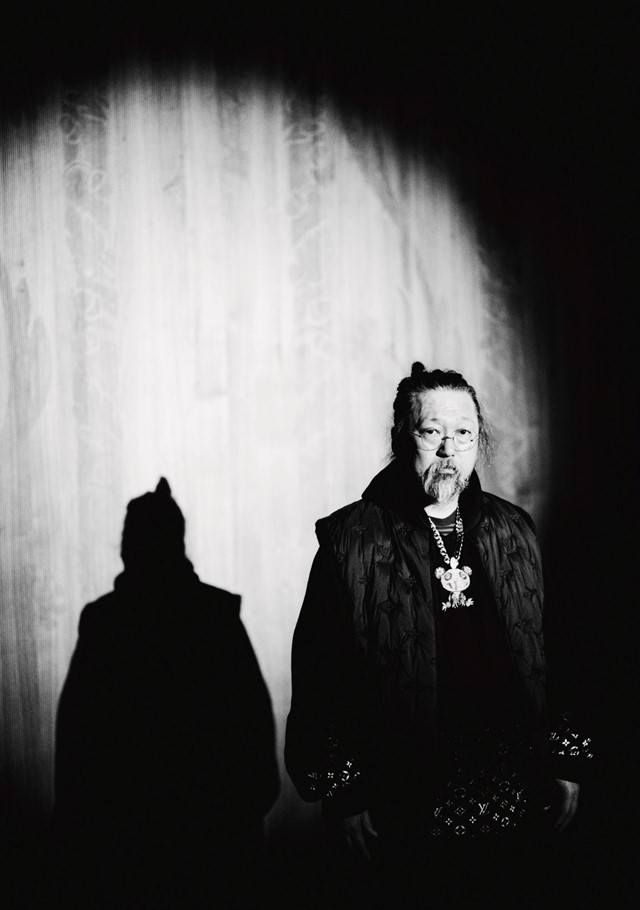Fresh from the recent re-edition of his iconic Louis Vuitton collaboration, Takashi Murakami talks about his love of early Edo period artist Iwasa Matabei
This article is taken from the Spring/Summer 2025 issue of AnOther Magazine:
“When I was 31 years old, I read a book by the Japanese art historian Nobuo Tsuji called Lineage of Eccentrics, and that’s where I first encountered Iwasa Matabei’s painting Rakuchū-Rakugai-zu Byōbu [Scenes in and around Kyoto, c1615]. A bird’s-eye view of Kyoto and its surroundings, it captures the city with remarkable scrupulousness. There are more than 2,000 characters in the painting, each with their own detailed setting – you even feel a sense of motion, as though you are watching a movie. Mr Shinya Takahashi, the general manager at the Kyoto City Kyocera Museum of Art, requested my interpretation of the painting for my solo show there last year.
“When I was producing this work, I realised anew what I had thought when I was young, namely that Matabei, a 17th-century painter, had the same genes as Katsuhiro Otomo, a manga artist and film director known for his world-renowned 1998 work, Akira. Matabei must have had a special talent for memorising everything he saw in an instant because he was able to create such paintings in an age when there were no photographs or moving images. And Otomo, according to anecdotes from those around him, also has an incredible visual memory – for instance, being able to depict a Chinese restaurant he has been to only once without missing any details.
“The general audience may feel that copying would be an easy thing to do, but I believe you can’t make a copy that surpasses the original painting by just tracing lines without feelings. You have to let the soul of the original artist, in the act of making their painting, possess you, and to do that it is important to spend a few months getting into the artist’s mind and feelings while tracing the whole painting first.”
When Takashi Murakami opened his show Japanese Art History à la Takashi Murakami at Gagosian’s London outpost in December last year, the artist stood in front of his 13-metre-wide reinterpretation of Matabei’s famed work wearing a smiling-flower hat. This painting, four times the original’s size, combines intricate Edo-period characters with swathes of skull-embossed gold leaf and Murakami’s Superflat cartoon creatures in his trademark blurring of high and low art. The vast panorama was created in collaboration with a team of about 100 people, many from his company, Kaikai Kiki. Having grown up immersed in anime, the Tokyo-born Murakami set out to study animation before switching to, and following up with a PhD in, nihonga (traditional Japanese painting). His almost unsettlingly cute characters have long since infiltrated the art market, pop culture and fashion internationally. This season Louis Vuitton releases a re-edition of the artist’s influential collaboration with the house – his invitation from Marc Jacobs back in 2002 to reinvent the LV monogram marked the first collaboration between a global fashion brand and so-called high art. What started as a small throwback project, “actually turned into a huge, incredible promotion, and to be honest I’m a bit baffled, but of course I’m also really happy”, Murakami says. All the while, the artist serves as a passionate ambassador for Japanese creativity, representing Japan Cultural Expo 2.0 – an initiative from the Japanese government to promote the country’s arts and culture as it prepares for the World Expo 2025 in Osaka – and is also producing a 12-episode, TV-style animation that he hopes will stream worldwide. Murakami has never thought of himself as straddling the line between art and commercial projects but merely “changing the line”.
Hand-printing: Merrick d’Arcy-Irvine
This story features in the Spring/Summer 2025 issue of AnOther Magazine, which is on sale now.
